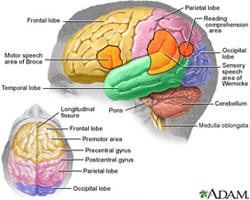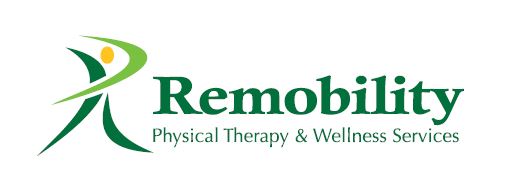From the Remobility newsletter archives
What is a Stroke?
 A stroke can affect men and women of all ages and carries with it damaging and potentially life-threatening complications. Simply stated, a stroke refers to an unexpected loss of brain function that occurs when blood flow to the brain is interrupted or when blood vessels in the brain rupture. When the blood flow is affected, the brain cells in the affected area die, and this can cause long-term damage.
A stroke can affect men and women of all ages and carries with it damaging and potentially life-threatening complications. Simply stated, a stroke refers to an unexpected loss of brain function that occurs when blood flow to the brain is interrupted or when blood vessels in the brain rupture. When the blood flow is affected, the brain cells in the affected area die, and this can cause long-term damage.
Depending on the area injured, a stroke can cause an individual to lose his or her ability to see, speak, read or write, along with loss of memory or an impaired thought process. Also, movement is limited to partial or full paralysis. The slightest of delays in blood flow can cause damage to the brain. The longer the brain goes without important nutrients and oxygen carried by the blood, the higher the risk of permanent damage.
What are the risk factors of stroke?
They are high blood pressure, high cholesterol levels, certain heart conditions, diabetes, obesity, smoking, stress, and drinking too much alcohol. In addition, women are subject to an extra set of risk factors, such as menopause and hormonal changes, as well as conditions associated with pregnancy and the use of birth control pills. A low activity level has further been linked to stroke risk, bringing yet another benefit to regular exercise.
Fortunately, you can identify a stoke early through FOUR MAJOR WARNING SIGNS and potentially decrease the severity of the damage:
- Weakness or numbness in the face, arm or leg
- Speech or comprehension trouble, vision problems
- Headache
- Dizziness
Each of these warning signs can occur alone or in any combination. So, learn and remember the list. Remember, timing is key. Getting treatment quickly can help counteract the damaging effects of a stroke. So if any of these warning signs occur, be sure to get medical attention immediately!
An easy way to assess someone who may be experiencing stroke is to remember to Act F.A.S.T. for Stroke (click for more information).
Physical Therapy and Stroke Recovery
You may not expect physical therapy to play an important part in stroke recovery, but physicians refer to it as an indispensable tool. While there are other types of stroke rehabilitation, including speech and occupational therapy, physical therapy specifically addresses physical damage. Of course, the type of assistance necessary depends on the type of damage that is present.
As physical therapists, we teach strengthening exercises to retrain the body following a stroke. Using a series of custom-designed stretches and exercises, we can help a stroke victim broaden his or her range of motion, build muscle, and increase endurance. Before establishing a treatment plan, we test the stroke victim’s current levels of motion, strength and endurance, and use this valuable information to create a plan that best suits the individual.
Word of Caution:
Never underestimate the range of treatment provided by your physical therapist. Even if the stroke victim is suffering from partial paralysis or weakness as a result of the stroke, physical therapy can prove to be very beneficial. In the case of paralysis, we can teach the stroke victim ways to compensate for the loss, in addition to prescribing treatment for the affected limb(s). For stroke sufferers forced to combat ongoing weakness, physical therapy can help to strengthen the extremities as a long-term solution. Physical therapy plays an integral role in stroke recovery. If you or someone you know has suffered a stroke, contact your physical therapist now to open a new door to recovery.
Are You at Risk for Stroke?
from the National Institute of Neurological Disorders and Stroke (NINDS)
Stroke ranks as the third leading killer in the United States. A stroke can be devastating to individuals and their families, robbing them of their independence. It is the most common cause of adult disability. Each year more than 700,000 Americans have a stroke, with about 160,000 dying from stroke-related causes.
Stroke occurs in all age groups, in both sexes, and in all races in every country. It can even occur before birth, when the fetus is still in the womb. In African-Americans, stroke is more common and more deadly–even in young and middle-aged adults–than for any ethnic or other racial group in the United States. Scientists have found more and more severe risk factors in some minority groups and continue to look for patterns of stroke in these groups.
Having a risk factor for stroke doesn’t mean you’ll have a stroke. On the other hand, not having a risk factor doesn’t mean you’ll avoid a stroke. But your risk of stroke grows as the number and severity of risk factors increases. Some of the most important treatable risk factors for stroke are:
- High blood pressure. Some ways to control hypertension: Maintain proper weight. Avoid drugs known to raise blood pressure. Cut down on salt. Eat fruits and vegetables to increase potassium in your diet. Exercise more. Your doctor may prescribe medicines that help lower blood pressure. Cigarette smoking. Cigarette smoking has been linked to the buildup of fatty substances in the carotid artery, the main neck artery supplying blood to the brain. Blockage of this artery is the leading cause of stroke in Americans. Also, nicotine raises blood pressure; carbon monoxide reduces the amount of oxygen your blood can carry to the brain; and cigarette smoke makes your blood thicker and more likely to clot. Your doctor can recommend programs and medications that may help you quit smoking.
- Heart disease. Common heart disorders such as coronary artery disease, valve defects, irregular heart beat, and enlargement of one of the heart’s chambers can result in blood clots that may break loose and block vessels in or leading to the brain. The most common blood vessel disease, caused by the buildup of fatty deposits in the arteries, is called atherosclerosis. A doctor can evaluate your risk factors for atherosclerosis and help you decide if you will benefit from aspirin or other blood thinning therapy.
- History of stroke. If you have had a stroke in the past, it’s important to reduce your risk of a second stroke. Your brain helps you recover from a stroke by drawing on body systems that now do double duty. That means a second stroke can be twice as bad.
- Diabetes. You may think this disorder affects only the body’s ability to use sugar, or glucose. But it also causes destructive changes in the blood vessels throughout the body, including the brain. Also, if blood glucose levels are high at the time of a stroke, then brain damage is usually more severe and extensive than when blood glucose is well-controlled. Treating diabetes can delay the onset of complications that increase the risk of stroke.
To assess your risk for stroke, use the Stroke Risk Worksheet, available online at
http://www.ninds.nih.gov/disorders/stroke/preventing_stroke.htm
Remobility teaches family members to assist with stroke recovery at home. We also provide free educational presentations to the community. Contact us for more information at 404-500-6978.
Feel free to submit any questions or concerns using the form below.
